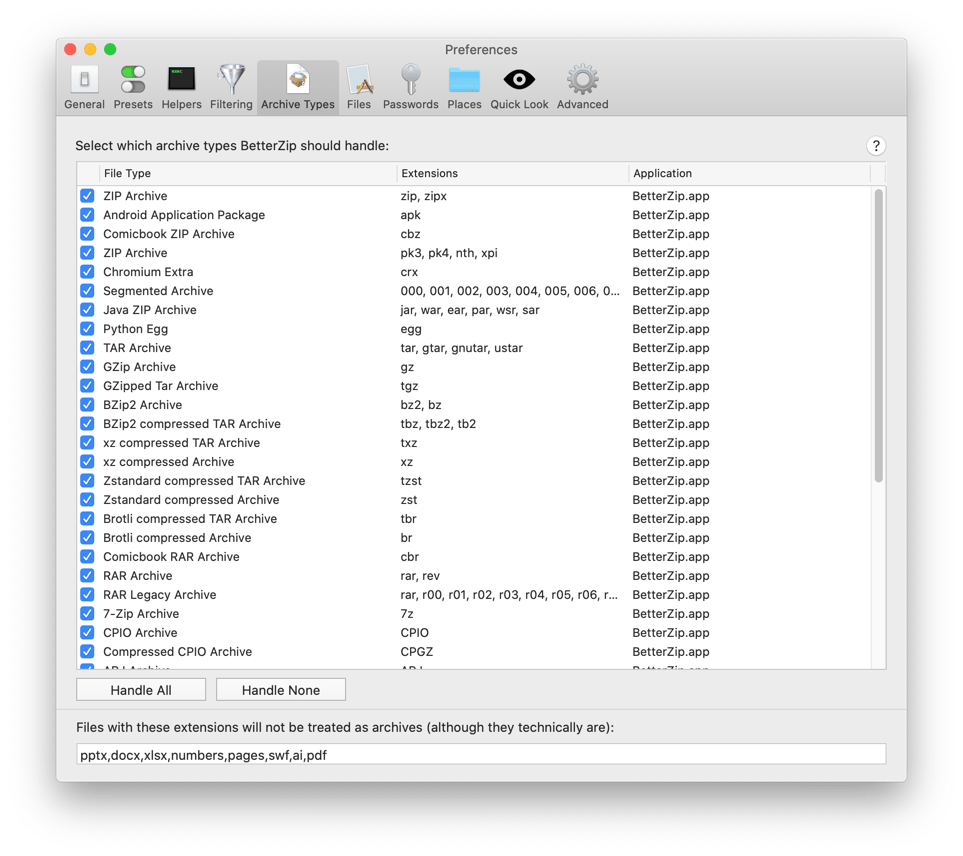- Extract A Zip File On Mac
- Extract Encrypted Zip File Mac
- Extract Zip File Mac Os
- Extract Split Zip Files Mac
- Extract A Zip File On Mac
- Unzip A Zip File Osx
RPM originally stands for Red Hat Package Manager. Nnow, RPM is a package management system. The name RPM variously refers to the .rpm file format, files in this format, software packaged in such files, and the package manager itself. RPM was intended primarily for Linux distributions; the file format is the baseline package format of the Linux Standard Base. RPM is distributed under the terms of the GPL.
Even though it was created for use in Red Hat Linux, RPM is now used in many GNU/Linux distributions. It has also been ported to some other operating systems, such as Novell NetWare (as of version 6.5 SP3) and IBM's AIX (as of version 4).
Rio would be very suitable for this - it uses the file extension of a file name to determine what kind of file it is, so it will work with a large variety of file types. I've also used unzip to list the file names within the zip file, so its not necessary to specify the file name(s) manually. If you have a Mac, you can still easily unzip or extract files from a ZIP file using Mac’s Archive Utility tool. Here’s how to open a ZIP file using the Archive Utility tool in Mac: Locate the ZIP file you want to open. If you’re not sure where you stored the ZIP file after downloading it, check the Downloads folder. Double-click the ZIP.
An RPM package can contain an arbitrary set of files. The larger part of RPM files encountered are 'binary RPMs' (or BRPMs) containing the compiled version of some software. RPM files however may also contain the source code, then called 'source RPMs' (or SRPMs) used to produce a package. SRPMs have an appropriate tag in the file header that distinguishes them from normal (B)RPMs, causing them to be extracted to /usr/src on installation. SRPMs also customarily carry the file extension '.src.rpm' (.spm on file systems limited to 3 extension characters, i.e. old DOS FAT).
The format is binary and consists of four sections:
- The lead, which identifies the file as an RPM file and contains some obsolete headers.
- The signature, which can be used to ensure integrity and/or authenticity.
- The header, which contains metadata including package name, version, architecture, file list, etc.
- A file archive (the payload), which usually is in cpio format, compressed with gzip. The rpm2cpio tool enables retrieval of the cpio file without needing to install the RPM package.
- More recent versions of RPM can also use bzip2, lzip, lzma, or xz compression.
- RPM 5.0 format supports using xar for archiving.
Open/Extract RPM File on Windows
Easy 7-Zip opens/extracts RPM file easily on Windows. The Easy 7-Zip was developed based on 7-Zip. 7-Zip is a famous open source file archiver. The Easy 7-Zip is an easy-to-use version of 7-Zip. The open source freeware keeps all features of 7-Zip and adds a few useful features that makes the software more user-friendly.
Easy 7-Zip works on Windows 10/8.1/8/7/Vista/2008/2003/XP/2000 (both 32-bit and 64-bit compatible).
- Free Download Easy 7-Zip
- Install Easy 7-Zip by step-by-step instructions
- The installation will associate RPM with Easy 7-Zip automatically
- Double-click on RPM file to open RPM file with Easy 7-Zip
- Alternatively, Right-click on RPM file on Windows Explorer
- Done
You will see files or folders within the RPM file then, click button Extract to extract the RPM file.
And then, choose Extract files..., Extract Here, or Extract to 'folder' to extract the RPM file.
Easy 7-Zip Download Links:
You can try other alternative freeware that opens/extracts RPM file on Windows. For example:
- PeaZip
- TUGZip
- B1 Free Archiver
- IZArc
- Zipeg
- Universal Extractor
- FreeArc
- Bitser
Open/Extract RPM File on Mac
B1 Free Archiver opens/extracts RPM file on Mac. B1 Free Archiver is a free software for creating archive folder and extracting archive file. B1 Archiver works on all platforms - Windows, Linux, Mac and Android. The freeware supports most popular formats including RPM.
B1 Free Archiver is compatible with:

- Mac OS X 10.9 Mavericks
- Mac OS X 10.8 Mountain Lion
- Mac OS X 10.7 Lion
- Mac OS X 10.6 Snow Leopard
Alternative freeware that opens/extracts RPM file on Mac.
- The Unarchiver
- Zipeg for Mac
- EZ 7z
- 7zX
Open/Extract RPM File on Linux
RPM (RPM Package Manager) is a popular utility for installing software on Unix-like systems, particularly Red Hat Linux.
Install RPM package on Linux, type:
| # rpm -ivh package.rpm |
Upgrade RPM File, type:
| # rpm -Uvh package.rpm |
Remove (Erase) RPM package, type:
| # rpm -ev package_name |
List all installed packages, type:
| # rpm -qa |
To extract a RPM package files without installing it, you need to install rpm2cpio. rpm2cpio extracts cpio archive from RPM Package Manager (RPM) package.
Install rpm2cpio on CentOS and Fedora
| # yum install rpm2cpio |
Install rpm2cpio on Debian and Ubuntu
| # apt-get install rpm2cpio |
Extract RPM file on Linux
| $ mkdir pkgname $ cd pkgname $ rpm2cpio ../package.rpm | cpio -idmv |
cpio arguments:
- -i: extract
- -d: make directories
- -m: preserve modification time
- -v: verbose
List files in RPM package:
| $ rpm2cpio package.rpm | cpio -t |
Tips: on Debian or Ubuntu, you can convert RPM to DEB package with alien, and process DEB package with dpkg; or process RPM file directly using smart.
Copyright © 2013-2017 James Hoo All rights reserved.ZIP files are necessary for combining multiple files together into one downloadable file. You can get many files in one lump while also compressing the file to allow for a quicker download. This has become a necessary method of downloading portable files for USB or other uses. While it’s necessary to unzip these files with a tool like WinRAR or 7-Zip, it always must be done manually. Today, however, we’ll look at how to set up a few things to automatically unzip a compressed file so you can get to the files within in much quicker.
The steps necessary to automatically unzip ZIP files is to run a batch file that uses 7-Zip against a download location so it extracts the contents and then discards the original ZIP file. This is done with a folder monitoring software. While these steps may seem daunting at first, they are simply using versatile utilities that must be adapted for this project, and therefore must be precise.
Walk through these step by step and you’ll have no problem setting it up.
Set Up 7-Zip
7-Zip is necessary for using the command line operations of its extraction capabilities.
Step 1: Install 7-Zip from this link here.
Step 2: Open the System Properties by right-clicking Computer from the Start menu and choosing Properties.
Step 3: Click Advanced system settings from the left pane. This will open the System Properties window.
Step 4: Click the Advanced tab and then choose Environment Variables.
Step 5: Double-click the variable called PATH and enter a semicolon at the end of the value. Immediately following the semicolon, enter the path to the 7-zip installation directory. The path in this example is C:Program Files7-Zip, but yours may be slightly different.
Ensure to OK out of all the open windows to save the variable change. This step is necessary for when we call the 7-Zip program from the command line.
Create a Batch File that Extracts a ZIP File Using 7-Zip
Now that 7-Zip has been installed, it’s necessary to create a small program that will extract any ZIP file in a certain folder.
Before starting, it’s important to note where your downloads go. Whether you’re using Chrome, Firefox, Internet Explorer, etc., every downloaded file is either automatically sent to a certain folder or the browser asks you where the download should go.
Cool Tip:Visit this link for a few download managers you can use in Chrome.If the downloads go to the same folder every time, identify this folder and jot it down. If you choose where every downloaded file will go, simply ensure you choose a common one and then use that location in the below command.
Step 1: Open Notepad and enter the following for the first line:
7z x –oDOWNLOAD-LOCATION* EXTRACT-LOCATION*.zipFor example, this is what my first line of commands is:
7z x -oC:UsersJonDownloadsDownloadedFiles* C:UsersJonDownloadsDownloadedFiles*.zipNote:Extract A Zip File On Mac
There is not a space after the command 7z x –o and before the DOWNLOAD-LOCATION section. There also cannot be any spaces in the pathname to the downloads folder.At this point, when the batch file runs, any ZIP file in the downloads folder will extract automatically and land in a folder in the same directory with the same name as the compressed file. However, the original ZIP file still remains. This is unnecessary and may even cause issues when we move on to the remaining steps. Therefore, we must include a command to either remove the ZIP file or move it out of the way and into its own folder.
Step 2: If you’d like to move the downloaded ZIP to another folder, create a folder called ZIP-Originals and place it in your downloads folder.
Step 3: Add the following under the existing commands in Notepad:
move DOWNLOAD-LOCATION*.zip DOWNLOAD-LOCATIONZIP-OriginalsThis is what mine ends up as:
 move C:UsersJonDownloadsDownloadedFiles*.zip C:UsersJonDownloadsDownloadedFilesZIP-Originals
move C:UsersJonDownloadsDownloadedFiles*.zip C:UsersJonDownloadsDownloadedFilesZIP-OriginalsAlternatively, if you’d like to simply remove the downloaded ZIP file, use this command instead:
del DOWNLOAD-LOCATION*.zip
Step 4: Save this file anywhere as one with a .bat extension under the All Files file type.
Run the Batch File When a ZIP File is Downloaded
To automatically run a batch file upon the criteria of a new download, it’s necessary to use a program called Directory Monitor.
Step 1: Download Directory Monitor from this link here.
Cool Tip: Learn how Watch 4 Folder can also monitor folder activity.Step 2: Open the program and choose the three small dots to browse for a download directory.
Find the folder and click the Select Folder button.
Step 3: Right-click the newly added directory and click Edit.
Step 4: Ensure the New Files checkbox is checked under the Events and Options section. Move down a bit further under Execute Applications to browse for the batch file you created in Step 4 above. Next to Only execute, enter a small number like 3 or 5 so the batch file is sure to run only when the file has been completely downloaded.
Step 5: Return to the main menu after saving the changes and open File > Options.
Choose to load the program at system start and then add .zip as a global include pattern in the bottom right text area. This ensures that ZIP files are included in the criteria to launch the batch file.
Extract Encrypted Zip File Mac
Note: ZIP files aren’t the only file types 7-Zip can handle. Therefore, if you would like to set these steps up with a RAR, 7Z, DMG, etc. compressed file, simply change every instance of ZIP with the preferred extension type.
Conclusion
Extract Zip File Mac Os
Extracting ZIP files shortly after download without intervening in the process will surely make using the files that much quicker. The task is fully automatic and can be left alone after setting it up.
Extract Split Zip Files Mac
The above article may contain affiliate links which help support Guiding Tech. However, it does not affect our editorial integrity. The content remains unbiased and authentic.Extract A Zip File On Mac
Read Next
Top 4 Tools to Extract RAR Files in Windows 10
Unzip A Zip File Osx
Struggling to extract a RAR file in
